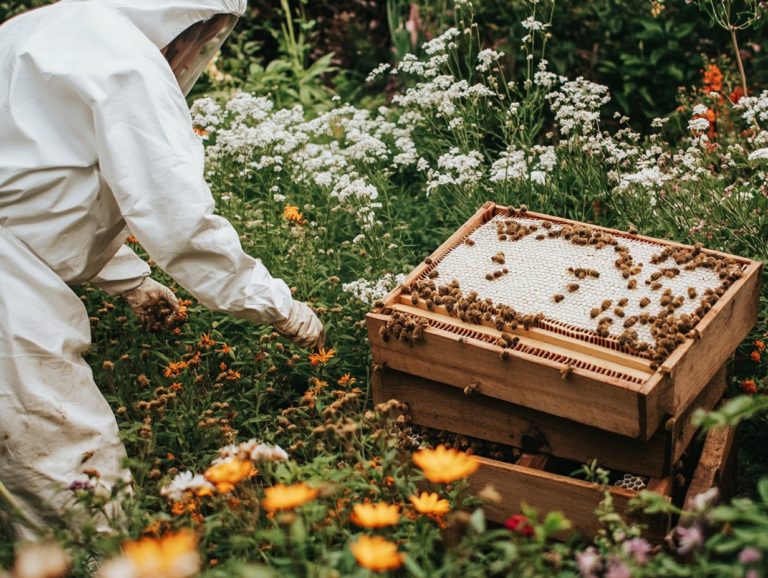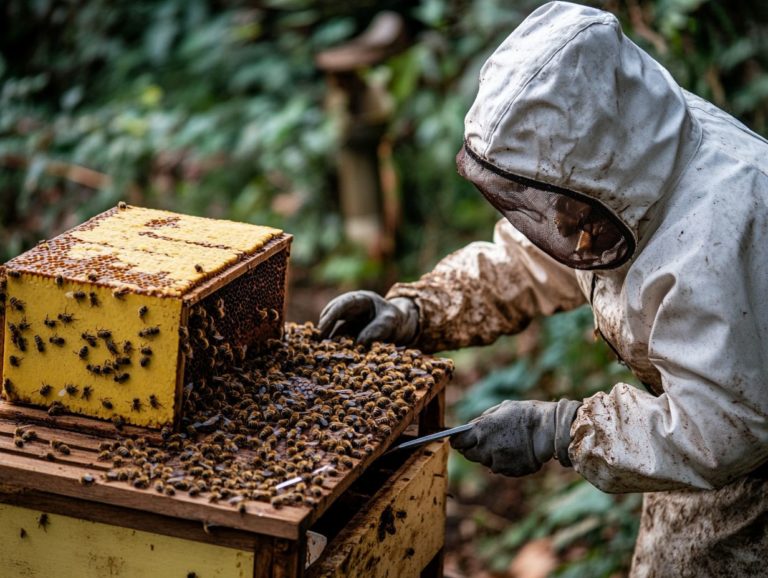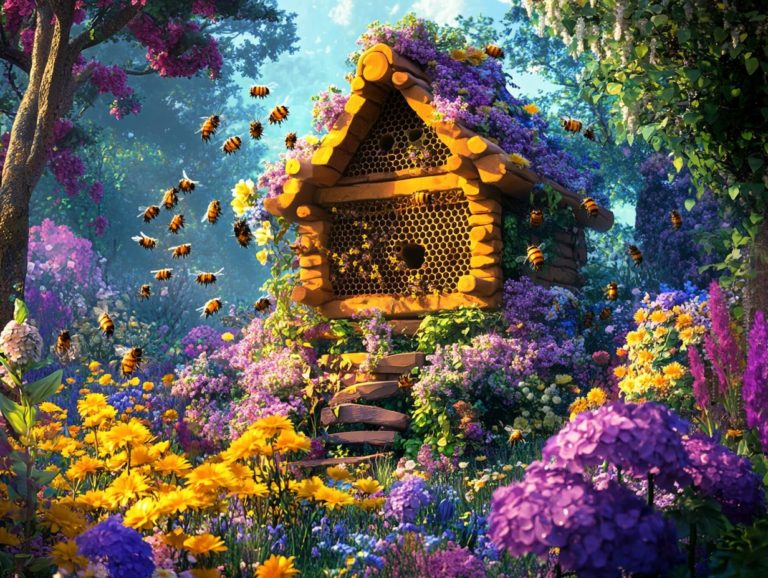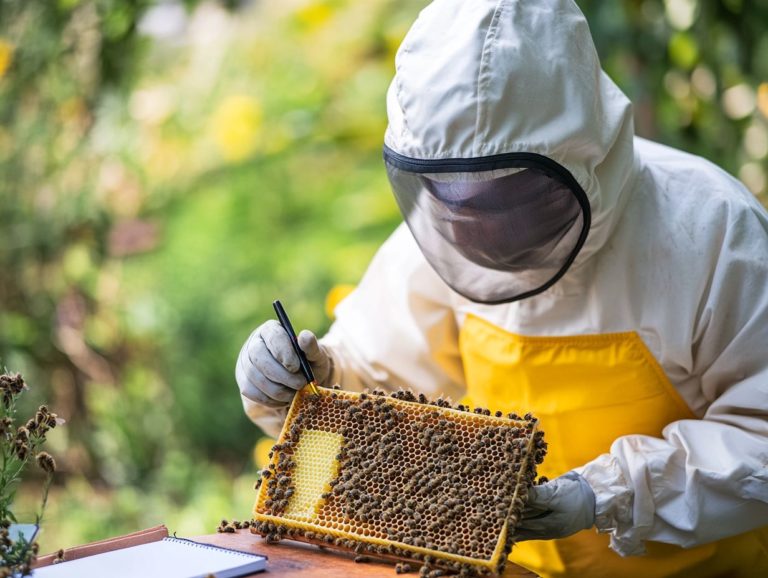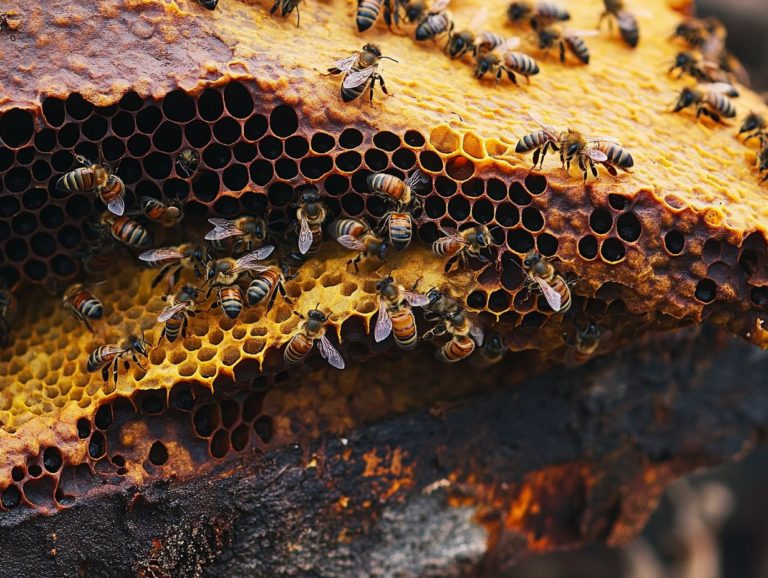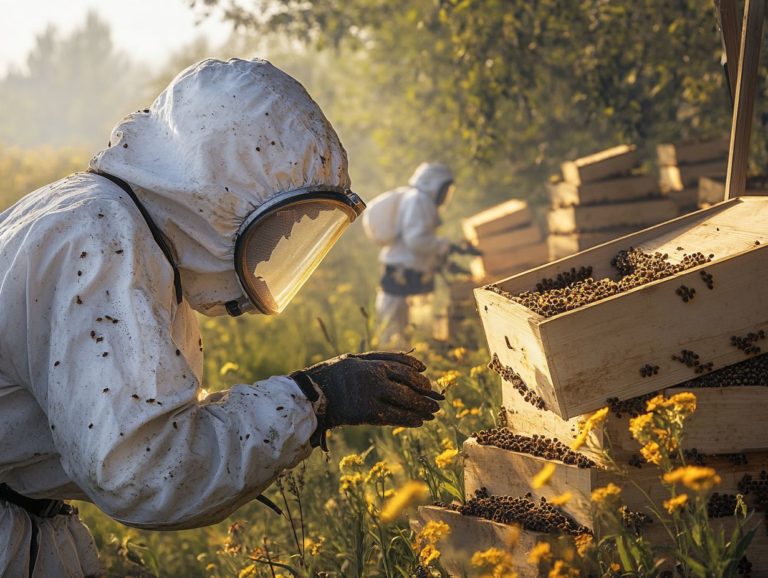How to Use Smoke Properly During Hive Management
Unlock the secrets of successful beekeeping by mastering the art of smoke! Smoke serves a pivotal role in hive management, offering you an indispensable tool to soothe bees and streamline hive inspections. Lighting a smoker correctly and using it effectively are essential skills for every beekeeper.
This article delves into the purpose of smoke in beekeeping, guiding you on how to use it while exploring the diverse types of smokers and fuel materials available. You ll also discover how smoke influences bee behavior and honey production, including its role in masking the alarm pheromone the chemical signal bees release to warn their colony of danger. Additionally, we will discuss crucial safety precautions to ensure a seamless and secure beekeeping experience.
Contents
- Key Takeaways:
- What Is Smoke in Hive Management?
- Why Is Smoke Used in Hive Management?
- How to Use Smoke Properly in Hive Management?
- What Are the Effects of Smoke on Bees?
- What Are the Alternative Methods to Using Smoke in Hive Management?
- What Are the Safety Precautions When Using Smoke in Hive Management?
- Frequently Asked Questions
- What is the purpose of using smoke during hive management?
- How should I light and use my smoker during hive management?
- What type of fuel should I use in my smoker?
- When should I use smoke during hive management?
- What precautions should I take when using smoke during hive management?
- How long does the calming effect of smoke last?
Key Takeaways:
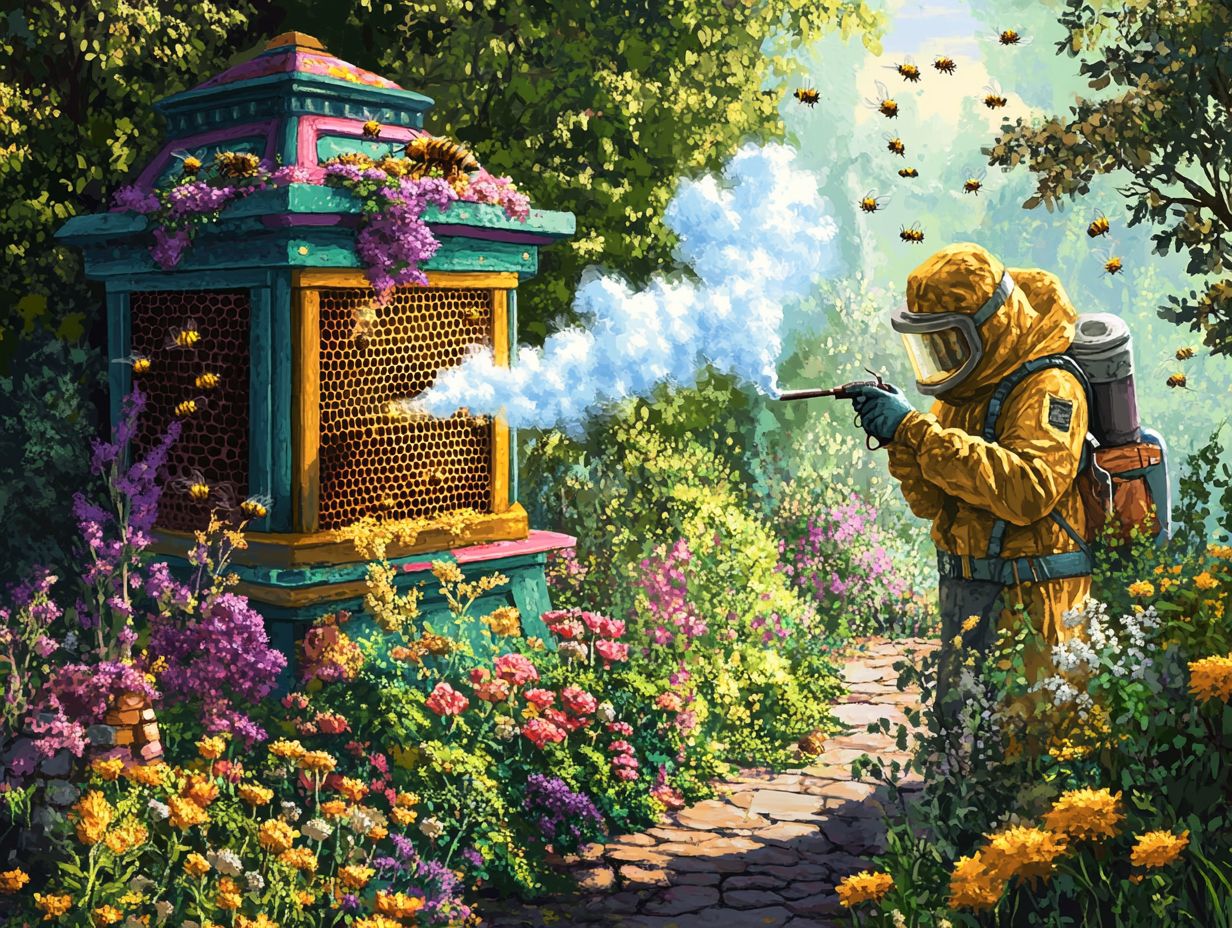
- Use smoke to calm bees during inspections and keep stings at bay!
- Choose the appropriate type and amount of smoke to manage bees effectively without causing harm.
- Consider alternative methods and follow safety precautions when using smoke for hive management.
What Is Smoke in Hive Management?
Smoke holds a vital position in hive management, enabling you to manage your bee colonies more effectively. It is one of the essential tools in your beekeeping arsenal, allowing for tranquil interactions with honeybees during hive inspections and overall beekeeping tasks.
When used correctly, a bee smoker produces smoke that confuses the bees and calms their agitation, making your beekeeping tasks more manageable. Understanding these smoke reactions is crucial for effectively calming honeybees. This technique dates back to Ancient Egypt and is practiced in regions like Georgia, remaining essential for both novice and seasoned beekeepers.
Why Is Smoke Used in Hive Management?
Smoke plays a pivotal role in hive management, expertly calming honeybees and reducing their agitation during routine inspections and harvesting. By masking the alarm pheromone, the strategic use of smoke becomes an essential technique that facilitates safer interactions between beekeepers and their colonies. Beginner beekeepers often find this method invaluable for managing stress in the apiary.
This practice is especially important for novice beekeepers who are still honing their skills in interpreting bee behavior. By employing smoke, they can alleviate any panic and minimize the risk of stings, ensuring their overall beekeeping needs are effectively addressed. Smoker safety tips are crucial for ensuring that the usage of smoke remains beneficial and harmless.
How to Use Smoke Properly in Hive Management?
Using smoke effectively in hive management requires essential steps that ensure successful application and safety for both you and your bee colony. Properly lighting a smoker and managing the smoker’s bellows are fundamental skills for beekeepers.
Begin by lighting your smoker with appropriate fuel materials, such as burlap, cotton fiber, pine cones, or pine needles, to produce steady, cool smoke. Once your smoker is lit, apply the smoke gently yet effectively to the hive, ensuring that the kindling is burning properly for a consistent smoke flow. This creates an atmosphere where the bees are less likely to become defensive during inspections or honey harvesting.
Mastering this technique is crucial for your success in beekeeping and the long-term health of your hive.
What Are the Different Types of Smokers Used in Beekeeping?
You ll find a variety of smokers available for beekeeping, each tailored to meet your specific needs and preferences as a beekeeper. Brands like Mann Lake offer many choices. Innovations inspired by pioneers such as Moses Quinby have also advanced smoker designs. From traditional models with a straightforward fire chamber to modern, meticulously engineered designs, these smokers use different fuel materials to produce smoke effectively.
Some smokers even include handy features like adjustable air vents and ergonomic handles. These advancements make them indispensable tools for both novice and experienced beekeepers.
Each type of smoker comes with its own unique benefits and drawbacks. Traditional smokers, often made from durable metals, promise longevity through regular use. However, they may demand a bit more skill to operate efficiently.
In contrast, modern smokers frequently feature adjustable air vents and ergonomic handles that enhance usability and control. While they may come with a heftier price tag, many beekeepers find that the efficiency they offer justifies the investment.
By understanding these differences and exploring options from reputable brands, you can dramatically boost your hive’s health and honey production. Choosing the right smoker is not just a decision; it’s a crucial aspect of effective beekeeping that can lead to rewarding results.
What Materials Can Be Used to Produce Smoke?
The production of smoke for managing your hive hinges on the selection of various fuel materials, each playing a distinct role in the quality and effectiveness of the smoke you generate. You ll find that common materials like cotton fiber, pine cones, pine needles, and burlap excel as kindling for smokers, providing a steady and reliable source of smoke.
It s essential for you to understand which materials burn cleanly and produce minimal soot, as this knowledge is key to maintaining hive health and ensuring successful inspections.
Consider using wood chips and pellets from fruit trees, like the Ohia tree. They burn slowly and efficiently while imparting unique flavors to your honey. These materials generate ample smoke while keeping the hive calm during inspections, which helps reduce stress for both you and your bees.
The choice of fuel significantly impacts the temperature and density of the smoke. Therefore, it s crucial for you to experiment with various types to discover the combination that works best. Beekeeping equipment, including the smoker, should be maintained and chosen carefully to ensure the best results.
By properly managing these fuels, you can enhance your overall hive management process, resulting in healthier bees and improved honey production over time.
What Are the Best Times to Use Smoke in Hive Management?
Identifying the optimal times to use smoke in hive management can significantly elevate the efficiency of your hive inspections and interactions with the bee colony. Generally, the early morning or late afternoon, when bees are less active, offers ideal moments for introducing smoke to facilitate your approach to the hive.
By steering clear of periods of high bee activity, you maximize the calming effects of smoke. This allows you to perform your tasks with minimal disruption to the colony.
Understanding the natural behavior of bees is essential; they tend to be less agitated during the cooler parts of the day. By planning your hive inspections around these times, you not only reduce stress on the bees but also create a smoother workflow for yourself.
You might find it beneficial to take advantage of the temperature drop during the evening hours or the gentle warmth of early mornings when the sun is just beginning to rise. Keeping an eye on weather conditions and hive activity levels in the days leading up to your inspection can further refine your timing.
By implementing these strategies, you can ensure that your hive management tasks are conducted effectively, providing your bees with the best possible environment during inspections.
How Much Smoke Should Be Used?
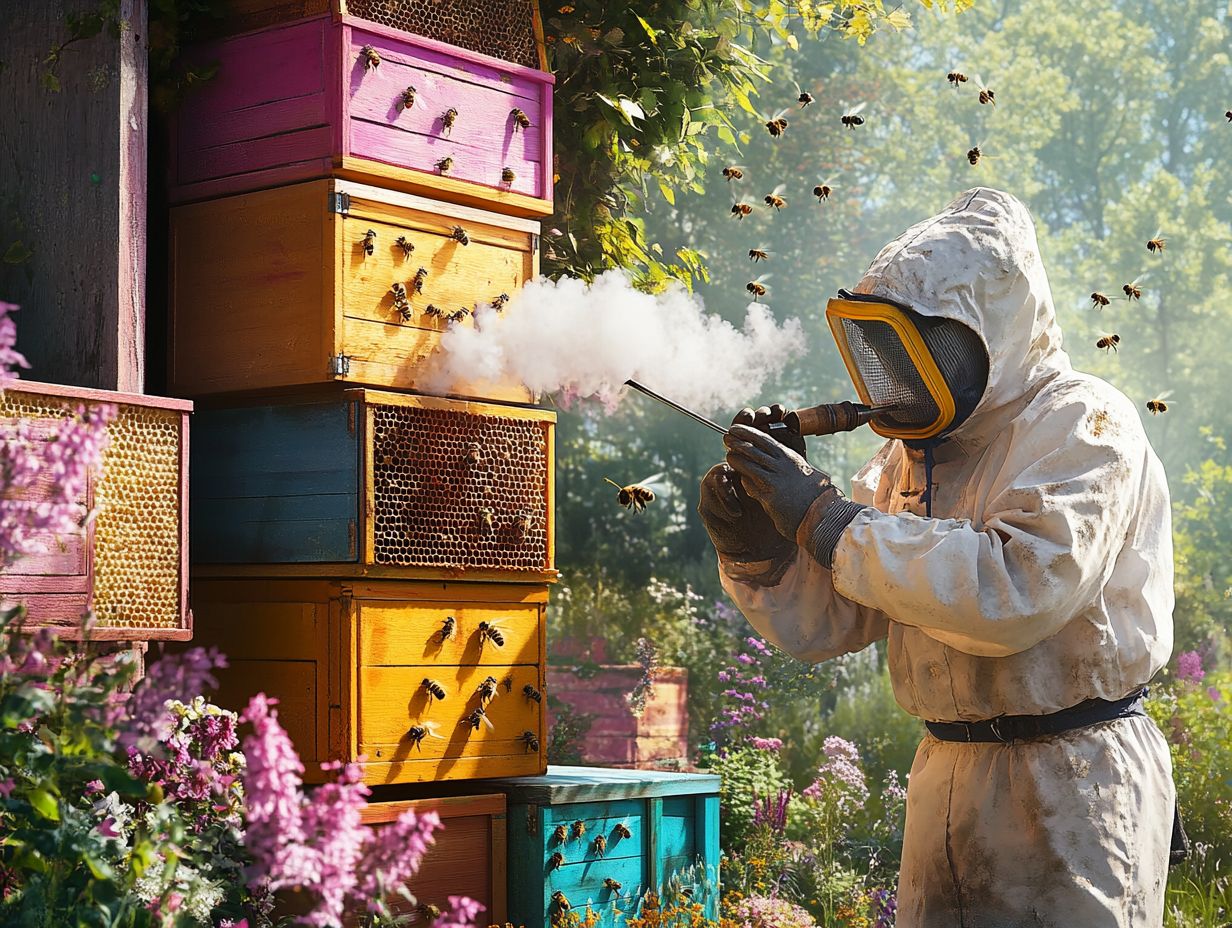
Determining the right amount of smoke for effective hive management is essential for achieving that perfect calming effect without overwhelming the bee colony. A light application of smoke typically does the trick, as too much can stress and disorient the bees, undermining your efforts to keep them calm.
The goal is to generate just enough smoke to create a gentle ambiance. This allows the bees to perceive it as a signal of potential danger, prompting them to prepare for evacuation rather than engage in defense. This practice is vital in beekeeping management to avoid over-stressing the bee colony.
To strike this balance, assess the environmental conditions around the hive and observe the bees’ behavior before applying any smoke. On hot days, for instance, the bees tend to be irritable, so you might need to apply a bit more smoke to soothe them effectively. Conversely, if you notice the bees clustering near the entrance or appearing lethargic, it could indicate that you’ve used too much smoke, which may agitate the colony.
Paying close attention to the bees response after applying smoke can guide your adjustments. Ideally, you want to see calm yet active movements. If the bees are panicking, it s a clear signal to reduce the smoke level on your next visit.
What Are the Effects of Smoke on Bees?
The effects of smoke on bees are intricate, particularly in terms of its calming influence during hive management. When used correctly, smoke induces specific reactions in honeybees that help temper their natural defensive instincts, allowing you to conduct inspections with minimal disruption.
Smoke acts as a sensory disorienting agent, masking the alarm pheromones that bees release when they sense a threat. This fosters a more manageable environment for both you and the colony.
How Does Smoke Calm Honeybees?
Smoke works its magic on bees by disrupting their natural communication, particularly by masking the alarm pheromone that signals danger. Instead of preparing to defend their home, bees interpret smoke signals as a cue to prepare for evacuation. This remarkable shift allows you, as a beekeeper, to approach hives without inciting aggression, crucial for effective hive management, especially during inspections and honey harvesting.
Beyond disrupting alarm signals, smoke triggers physical changes in bees, potentially raising their body temperature and prompting them to consume honey reserves in preparation for a possible retreat. This feeding behavior distracts them and lessens their tendency to sting, as well-fed bees are typically less defensive.
By understanding these behavioral patterns, you can employ strategies, such as optimal smoke application techniques. This ensures the right amount is used to cultivate a calm atmosphere while minimizing any stress on the colony. Ultimately, mastering smoke use fosters safer interactions, promoting better hive health and enhanced productivity.
Does Smoke Harm Bees?
While you can use smoke as a valuable tool in your hive management toolkit, it’s important to discuss how smoke can impact our buzzing friends! When used responsibly and in moderation, smoke typically poses no threat to bees. However, excessive exposure can lead to stress and adversely affect hive health.
Understanding safe practices and the proper application of smoke is essential for maintaining your colony’s well-being and ensuring the longevity of your beekeeping efforts.
Strive to find a balance that maximizes the benefits of smoke while minimizing its risks. One effective approach is to use gentle, low puffs of smoke instead of a heavy or continuous stream. This technique calms the bees without overwhelming them.
Limit your smoke application to critical moments, such as during inspections or hive manipulations. Avoid smoking when the bees are already stressed from environmental factors. By being mindful of these methods, you can safeguard bee health and support a flourishing ecosystem.
Does Smoke Affect Honey Production?
The impact of smoke on honey production is a crucial consideration for beekeepers. Smoke can significantly influence the overall health and productivity of your bee colony.
While smoke is a helpful tool for handling hives and ensuring safe interactions with your bees, overusing it can raise stress levels and potentially reduce honey yield. Finding the right balance in smoke application is vital for maintaining a healthy hive environment that encourages optimal honey production.
When bees are stressed, their ability to forage, communicate, and produce honey can decline. This is a real concern for those committed to sustainable beekeeping.
You can adopt various strategies to minimize stress, such as monitoring smoke application techniques, selecting the right moments for hive inspections, and ensuring proper ventilation within the hive.
Maintaining stable hive conditions, including temperature and humidity, is essential for supporting bee health. By understanding the needs of your colony and using smoke wisely, you can create an environment where your bees thrive and maximize honey output.
What Are the Alternative Methods to Using Smoke in Hive Management?
Beekeepers exploring alternatives to traditional smoke methods in hive management have a range of effective strategies available to foster calm interactions with their bees.
Consider using a bee brush, a water spray bottle, or even essential oils. These innovative techniques allow you to manage bee behavior gracefully, without the anxiety that smoke might cause.
Using a hive tool can also help streamline hive inspections, ensuring safety and efficiency while minimizing disruptions to the colony.
By incorporating these diverse methods into your practices, you can elevate your hive management and adapt to various situations with ease.
1. Using a Bee Brush
A bee brush is a gentle tool for hive management that calms honeybees while minimizing disruptions during inspections. By lightly brushing bees away from frames or areas of interest without causing harm, you can effectively manage their behavior.
This method is a great way to keep things calm, especially with calmer colonies or when smoke isn’t the best option.
Using a bee brush provides an alternative technique, particularly when working with genetically gentle breeds or in situations where smoke could irritate the bees. This approach fosters a more tranquil atmosphere and enhances visibility for a thorough examination of the hive.
When using a bee brush, select one with soft bristles to avoid harming the bees. Use smooth, deliberate motions to prevent unnecessary agitation. The bee brush is particularly beneficial during brood inspections or when adding supers, allowing careful handling of the hive while minimizing disturbances.
2. Using a Water Spray Bottle
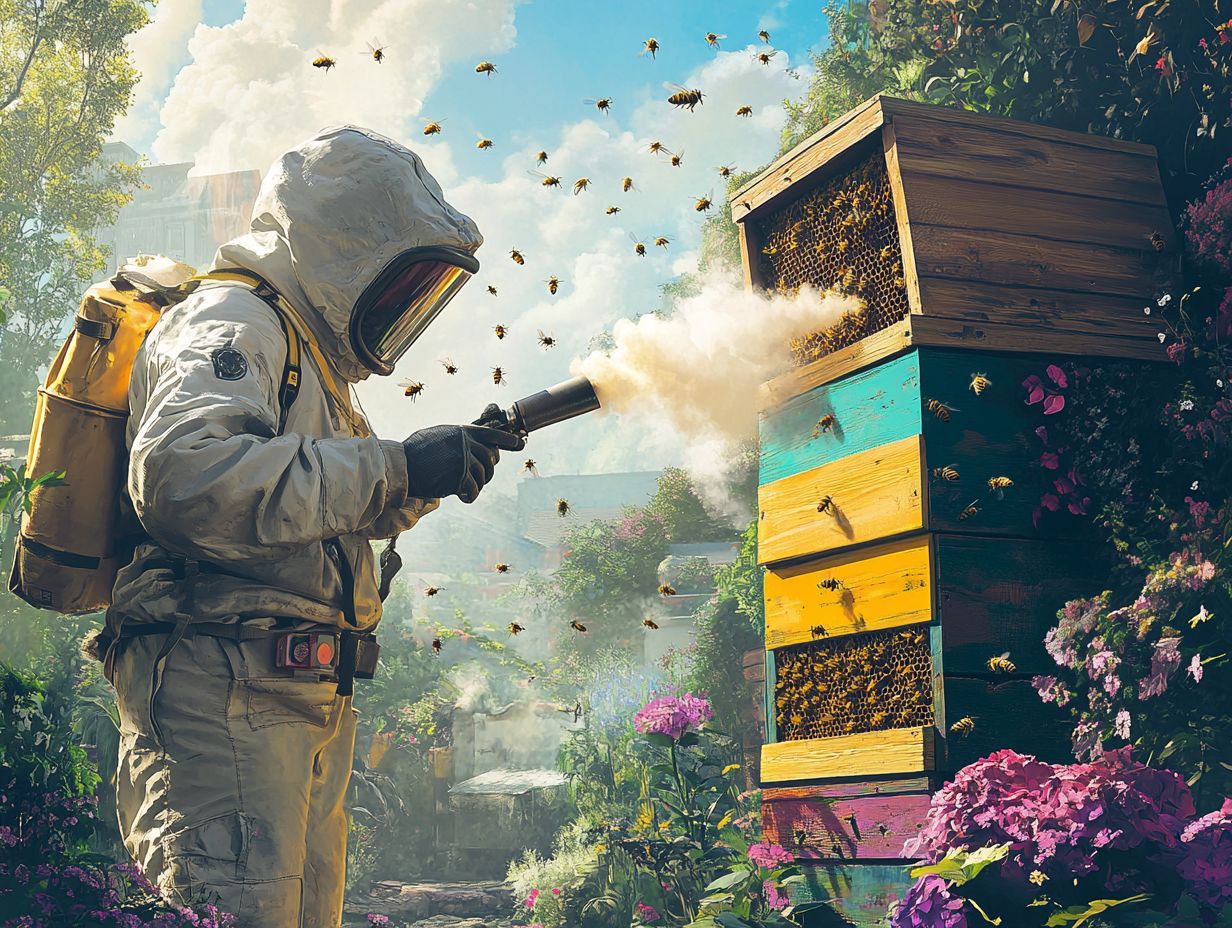
Using a water spray bottle is an excellent technique to calm honeybees during hive management activities. A gentle mist calms the bees and creates a humid environment, temporarily disorienting them. This allows you to carry out essential tasks without triggering their defensive instincts, especially on hot days when bees may be irritable.
This approach not only offers relief during sweltering temperatures but also proves advantageous during inspections or hive examinations, where close handling can easily agitate many bees. Lightly spritzing the air above the colony can diffuse tension and foster a more tranquil atmosphere, making it easier to conduct thorough checks.
This technique also helps prevent excessive heat buildup within the hive, which could negatively impact the colony’s health. Opting for a water spray bottle instead of traditional smoke allows you to preserve the bees’ natural behavior.
It offers a subtle alternative that won’t mask the pheromones essential for their communication, ensuring you maintain a respectful relationship with these remarkable creatures.
3. Using Essential Oils
Essential oils are creating quite a buzz in the beekeeping world. They offer a natural alternative for calming honeybees during hive management. Their soothing scents provide a gentler approach compared to the traditional use of smoke. Oils like lavender and lemon balm can create a calming atmosphere, reducing stress for both the bees and you, the beekeeper.
When applied correctly, these essential oils can elevate your hive management practices while fostering a healthier environment for your bee colonies. These natural substances not only cultivate tranquility but also support bee health with their antimicrobial properties.
You have various techniques for application; for instance, consider mixing essential oils into sugar syrup or using specially designed diffusers for targeted treatment. Many beekeepers have noticed that these oils can reduce aggressive behavior among the bees, making your hive inspections safer.
This shift towards eco-friendly alternatives reflects a growing awareness of sustainable practices in agriculture, ultimately benefiting the entire ecosystem. Embracing these methods aids your beekeeping efforts and contributes to a healthier planet.
4. Using a Hive Tool
Using a hive tool is a game-changer for effective bee management during inspections. This specialized equipment allows you to open hives and safely remove frames, reducing reliance on smoke to calm the bees.
When used correctly, a hive tool helps maintain order while minimizing stress for both you and the bee colony. This essential device does more than just lift frames; it also scrapes off propolis, a sticky substance made from tree resin that bees use to seal their hives, and wax buildup, keeping your hive in prime condition.
Its design ensures a firm grip and precision, making the inspection process smoother and less intimidating for the bees. By cutting down on smoke usage, you foster a calmer atmosphere, allowing closer observation of bee behavior and a better understanding of their needs.
Using a hive tool also plays a crucial role in successful hive management, enhancing overall hive health and productivity.
What Are the Safety Precautions When Using Smoke in Hive Management?
Implementing safety precautions while using smoke in hive management is essential for your well-being and that of your bee colony. A few simple safety tips can protect you and your bees don t skip these!
- First, always wear protective gear like gloves and veils to safeguard against potential stings.
- Always have a fire extinguisher nearby to keep your beekeeping adventure safe and worry-free!
By being aware of these safety practices, you enhance your beekeeping experience and ensure effective and secure hive management.
1. Wearing Protective Gear
Equip yourself with protective gear as a crucial safety measure when using smoke during hive management. Items like gloves, veils, and suits create a vital barrier against potential stings, allowing you to engage confidently and safely with your colonies.
The right protective gear enhances your personal safety and elevates your overall beekeeping experience. When selecting gloves, choose a sturdy yet flexible material that provides the dexterity you need while keeping those pesky bee stings at bay.
Lightweight suits made from breathable fabric offer comprehensive protection and should fit snugly to prevent any unwelcome visitors from sneaking inside. Don’t underestimate the veil; it s crucial for shielding your face and neck areas particularly vulnerable to more aggressive bees.
Maintaining your equipment is equally important. Regularly wash your suits, inspect your gloves for holes, and ensure your veils are free from tears. These simple checks prolong their lifespan and maintain optimal safety. Keeping your gear in top shape ensures calm and efficient interactions with the hive, making your beekeeping journey much more enjoyable.
2. Keeping a Fire Extinguisher Nearby
Keeping a fire extinguisher within reach is an important safety step for you as a beekeeper when using smoke in hive management. Since generating smoke involves combustion, having a fire extinguisher easily accessible allows you to manage any accidental fire quickly, preventing potential property loss and safeguarding your bee colony. This precaution becomes even more critical in dry environments, where the risk of fire is heightened.
Beyond simply having an extinguisher on-site, it’s essential to select the right type for your apiary. A multi-purpose fire extinguisher is designed to put out various types of fires, making it a versatile choice for beekeepers. Look for one rated for Class A, B, and C fires, as it can handle a variety of fire scenarios that may arise.
Familiarize yourself with how to operate your extinguisher and conduct regular checks to ensure it s in good working order. Establish best practices, such as maintaining a safe distance when using a smoker and avoiding windy conditions, to dramatically reduce fire hazards while managing your hives.
This proactive approach enhances the safety of both you and your bees and benefits the surrounding environment, fostering sustainable beekeeping practices.
3. Avoiding Overuse of Smoke
Avoiding the overuse of smoke during hive management is essential for safeguarding the health of your bee colony. Excessive smoke can elevate stress levels in bees, negatively impacting their behavior and productivity. By following smoker safety tips and using smoke sparingly, you can create a more productive environment for your colonies while minimizing any potential harm.
Frequent exposure to large amounts of smoke can disorient bees, disrupt their foraging patterns, and hinder their ability to communicate effectively within the hive. This disarray can ultimately lead to decreased honey production and a decline in overall hive strength.
It s exciting to discover how applying smoke lightly can improve your beekeeping experience! Use smoke primarily to calm the bees during inspections or hive manipulations. Explore alternative methods for soothing bees, such as employing gentle vibrations or maintaining a cool and calm demeanor. Conduct hive inspections during cooler parts of the day to reduce stress and enhance the overall health of your bee colony.
Frequently Asked Questions
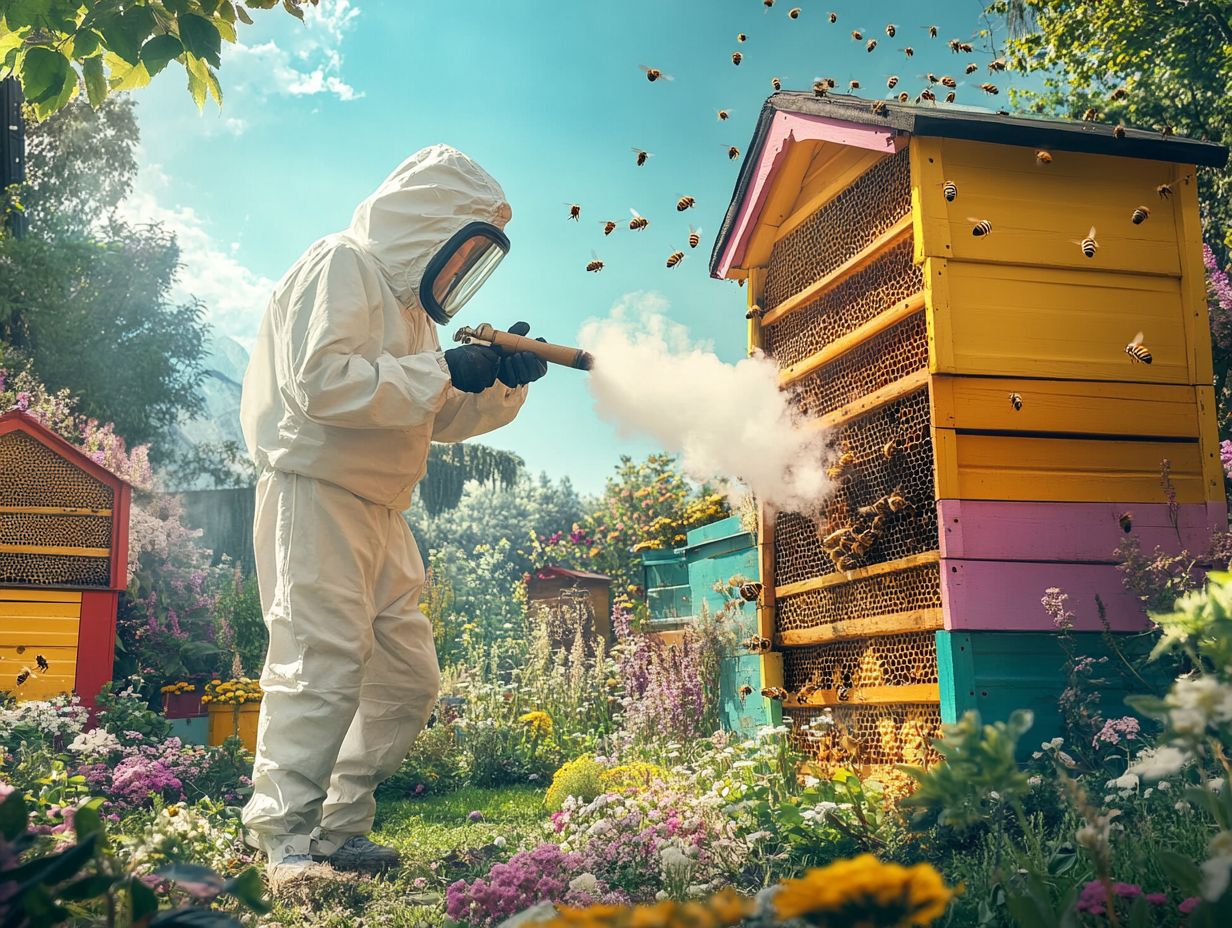
What is the purpose of using smoke during hive management?
Smoke is used to calm the bees and make them less likely to sting, making hive management safer for both the beekeeper and the bees.
How should I light and use my smoker during hive management?
Light the smoker using dry, cool smoke. Puff the smoke gently around the entrance of the hive and between the frames to distribute it evenly. Use only enough smoke to calm the bees, not to suffocate them.
What type of fuel should I use in my smoker?
Use dry, natural materials such as pine needles, sawdust, or wood chips to create smoke. Avoid using chemically treated or resinous materials, as they can harm the bees.
When should I use smoke during hive management?
Use smoke at the beginning of your hive inspection and whenever the bees become agitated. Avoid excessive use, as it can stress the bees and interfere with their communication and behavior.
What precautions should I take when using smoke during hive management?
Always wear protective gear, including a veil and gloves, when using smoke. Keep a safe distance from the hive to avoid accidentally burning the bees or igniting the hive. Never leave the smoker unattended.
How long does the calming effect of smoke last?
The calming effect of smoke typically lasts for a few minutes. If the bees become agitated again, it is safe to use more smoke to calm them down.
Explore more about beekeeping safety or share your experiences to create a richer community knowledge base!

